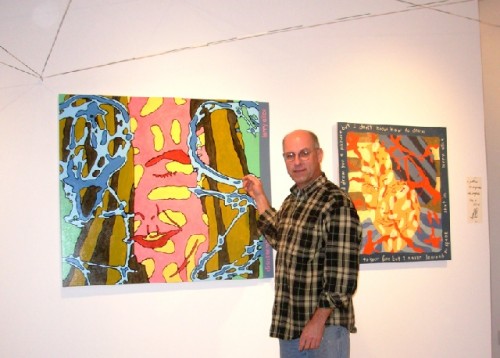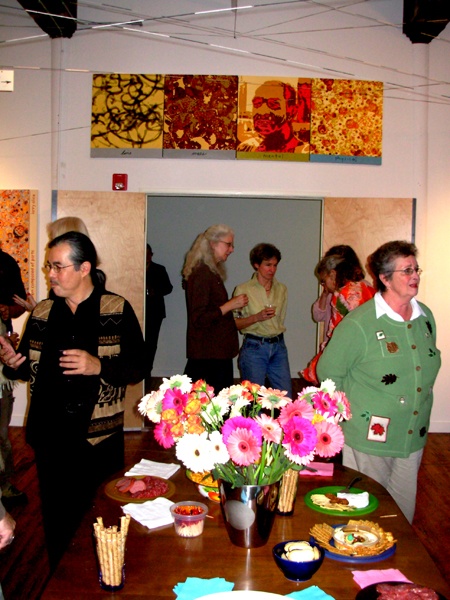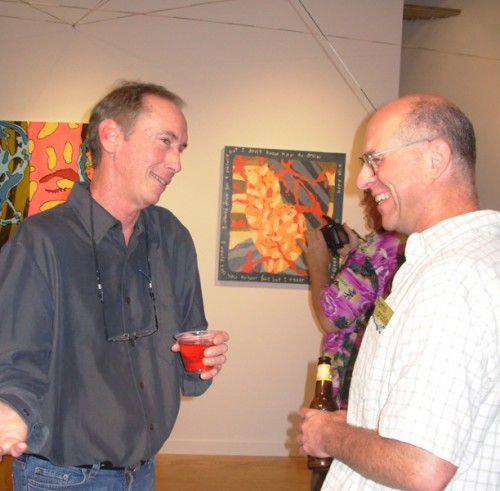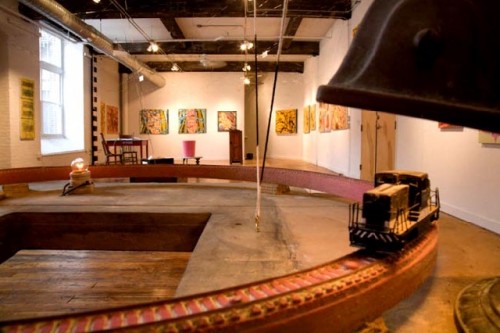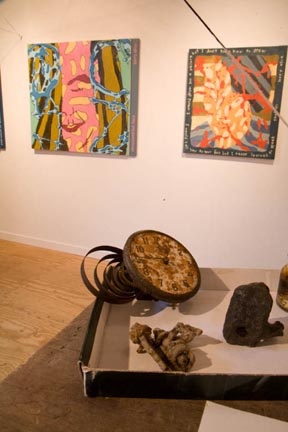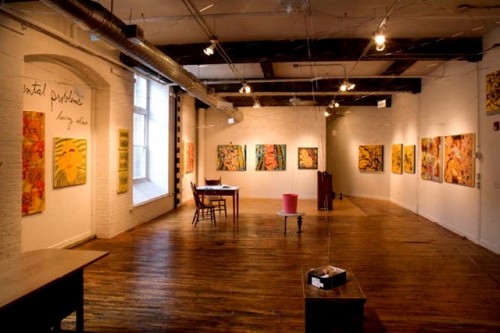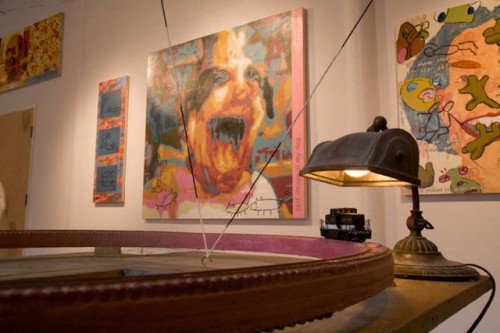Larry Alice One Man Show at Eclipse Gallery
North Adams Artist Discusses His Paintings
By: Charles Giuliano - Sep 27, 2007
Larry Alice Paintings
Eclipse Gallery
243 Union Street
North Adams, Mass 01247
September 15 through October 7
Hours: Saturday and Sunday, 1 to 5 pm
http://www.larryalice.com
http://www.northadamsopenstudios.com/ http://www.eclipsemill.com/
Looking around at a densely installed gallery at the Eclipse Mill in North Adams, with clusters of different themed paintings, several sculptural assemblages of found objects, and a spider's web of strings leading from one wall area to another with hand made signage explaining things, the artist, Larry Alice, who also answers to Larry Kurowski, commented that "I have been working on this my whole life. Taking things apart and being fascinated by the idea of systems."
Some four years in the studio preceded his first one man show in an East Village gallery in New York in 1984. With a bit of beginner's luck it was reviewed by Thomas McEvilley in Art Forum. He described "Nice large pieces made entirety by 1x2" pine boards and small, unconcealed rotary motors filled and activated the space extraordinarily. The largest piece called 'Movement Room' contains eight sets of eight motorized elements: all the sets are wired to the same timer box, though the eight elements within each group move independently. Each group expresses both its own esthetic and its relationship to and response to the othersÂ…"
Prior to having that first exhibition Alice had little or no direct contact with the art world. He came to art through the back door of electrical engineering, building things as a kid with his dad, and a number of years of working in theatre constructing sets. While still in high school he made a psychedelic light show which he rented out to rock bands. That landed him a gig in the set and design shop of a local college theatre department. His mother had been in the theatre. So he came from a background of just doing things. Eventually, a girlfriend, who was an artist, told him that the stuff he was making was art. That confused him and he responded that he thought you had to be an artist to make art. She said that it was the other way around. That making art made you an artist. It was an insight that brought some focus to what he had been doing all along.
It also explains the eccentricity of the current installation, the highly original paintings, and their conceptual approach. He runs counter to the conventional wisdom of gallerists who want to present a single and unified body of work. Here the artist is simultaneously working with a lot of different concepts that come together as a total installation. Some of the individual paintings work and make sense on their own terms. While other paintings are understandable only as contributing an element to an overall dialogue. You have to see the entire body of work in context to comprehend its thrust and insights. But looking at the work he has installed Alice commented how the color seemed to work from one painting to another. He pointed to two of the earliest paintings in the series in which a face of a woman is layered over his own face and that the conflated image was then further worked on with Photoshop and separated out into layers like a topographical map. Areas are bound by their own linear borders rather like a paint-by-numbers scheme. The artist pre mixes the colors and feels they must be precise and accurate to convey a three dimensional sense of volume. Sometimes a painting has to be repainted up to three times to get it absolutely right. The technique also lends itself to silk screen and multiples should there ever be the urge or demand to make editions.
It is also this conflation of gender, juxtaposing the male self image and the female one that explains why he has chosen the artist name Larry Alice. The Alice part derives from an old girlfriend and also suggests a reference to Alice in Wonderland as there is that kind of whimsical, amusing, playful, gender bending aspect to the work and the artist's persona.
From the artist's statement he describes the essential elements as "1. Take things apart. 2. Reduce the parts to their essence. 3. Construct something new with the parts." This is further clarified. "1. Parts. I spend a lot of time just playing with a pen, with photos, with paint, whatever. These get scanned in, manipulated and put into collections of parts. I have notebooks full of stories, phrases, intentional scribbles, drawings, patterns, textures, and color combinations. 2. Reduction. If each part is carefully considerered then what you build from the parts has more to work with. The parts are manipulated and reduced (abstracted). I'm not interested in realism. I'm interested in reference. 3. Construction. Parts are then selected and edited together on the computer to construct a particular image for a painting. Building an image is constructing a metaphor. A metaphor selects parts for their associations and then puts the parts together into a vehicle what is going somewhere."
Long before he focused on making art he grew up in the theatre. "I was always building things that were mixed with performances," he said. "A theatre is a big space that you are crawling around in. It is like being in your head with lots of places to explore."
I suggested that this notion sounded like the independent film "Being John Malkovich." He responded "Yes, like that movie, is how I think. He's a good example of that. Not John Malkovich, the actor, but that film. The film was funny and also had metaphorical overtures which are fun."
This prompted me to ask about humor as an element of the work which also includes some cartooning. "Yes, there is a playfulness," he replied. "The basic thing I do is take things apart. I make lots of little drawings. I have notebooks filled with them they are the parts I use over and over again."
Another aspect of the work is the element of performance and audience that derived from the theatre. "It started with installations and there was always the idea of presenting the work to an audience. I am not making the work to express myself like an abstract expressionist. I think of myself as a viewer like any other viewer. This work started when I wrote books. It comes from the top down starting with ideas and the last thing that comes out is a painting. It is about the life of the mind and making something complicated to look at. You start breaking it down. There is a part of the brain that looks at the world as pictures. The brain breaks down the information into concepts that we apply to looking at pictures."
To illustrate his point he showed me one of his artist books which he prints, assembles, and binds himself using a laser printer. He discussed a reproduction of a painting which clearly reads as a "portrait" of Marilyn Monroe rendered in his schematic manner. He discussed the coding process of the human brain which starts by recognizing the portrait element, Marilyn Monroe, as icon. On a secondary level the brain sees it as "Woman" and then as "Face." "So the drawings are a boiling down of pictures into concepts." To illustrate his point he suggested two characters "Bob" and "Mary" and how we construct layers of associations with each individually. He analyzed the process of what happens when we see them holding hands and how those separate identities and personas become conflated as a couple.
As a part of those endless notebooks and sketchbooks he often just makes scribbles and doodles. These may then be scanned and edited in Photoshop and eventually become paintings which are deconstructed as elements of other paintings. It gets complicated which is why he designed the current installation with strings connecting images and concepts and added signage to further explain his ideas. Many of the paintings have a vertical attachment on the right edge with a title and the artist's signature. Perhaps it's that engineering thing but he likes everything to be precise. While the work is complex he is not about obfuscation and hocus pocus.
Describing his schematic technique of painting he said that "I call these 'Topo' from the term topographical. I premix the color which has to be prefect to give it the modeling and convey that a head is round."
That's a lot of information to absorb so I changed direction and asked for some background. "My mom was a director and I spent three years in summer theatre at the Arrow Rock Lyceum in Missouri doing stage lighting and tech work." He said. He studied engineering at the University of Michigan and holds a Master's in Electrical Engineering from City College in New York. From building his own light show and working for a local college theatre he later worked for the Michigan Art Train while at the university. "It entailed four railroad cars and we traveled from town to town," he recalled. "It went all over Michigan, We stayed a week and then moved on. I was 19 and there were seven people on the train. It was madness. We worked all day and drank all night. Also, I was wandering around the country hitch hiking and doing summer stock theatre. I had a crisis in school and dropped out. I didn't understand what was being taught in my engineering classes. Up to then I could build things, read meters, see when things got too hot, soldered. I could make things but when I got to college it was about math and concepts. Going into final exams I just dropped out. I could have gotten a C but I didn't go to college to earn Cs. Later I went back and just sat in the library and studied and eventually aced the exams."
He describes how resolving that crisis profoundly changed him. "I realized that there were two worlds. On the one hand I could make things. There was the physical world of touch and taste and breathing. It hurts when you bump into something. It is the world of our senses. Then there is another world of concepts, metaphors and ideas."
By 1980 he moved to the West Coast and was living in a commune in Oakland. The group earned money by tearing down and selling for scrap abandoned buildings on a military base. It was here that a woman artist at a party suggested that what he was tinkering with was art. He moved to the East Village in New York and started making art in a loft. Four years later he had his first one man show at El Pueblo Gallery on Houston and another a year later at Dash & Dash Gallery in the East Village. That was 1985 and the East Village had a booming art scene. He earned a living as a part time engineer for a company that did outdoor laser light shows. Because he felt the work would grow faster he switched from installations to paintings. He made 4x6' paintings on masonite which he cut into 2x2' panels and reassembled.
In addition to working in the studio he married a photojournalist. He was making good money until the dot com crash in 2002. At the time they were living a high end lifestyle that it was no longer possible to sustain. Things feel apart including the marriage. It was time to get out of the city and he describes that he might have ended up anywhere. Attracted by Mass MoCA and what was going on in the Berkshires, he decided to rent a house, see if he liked living here, and to start looking around for an affordable loft. He ran into Eric Rudd at a moment when the Eclipse building was moving forward having been on hold for a number of months. He was put on a "waiting list" and within days was offered a space. The rest, as they say, is history.

